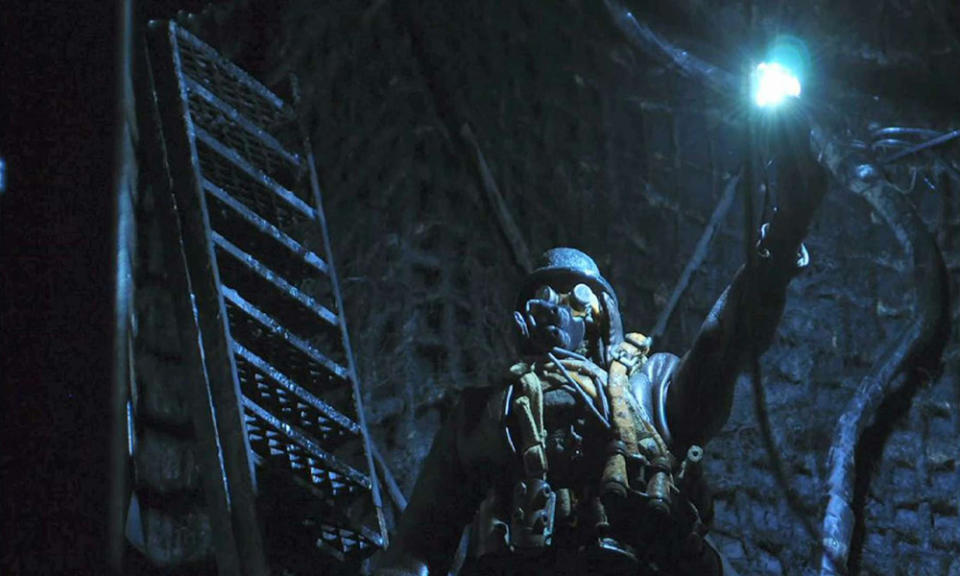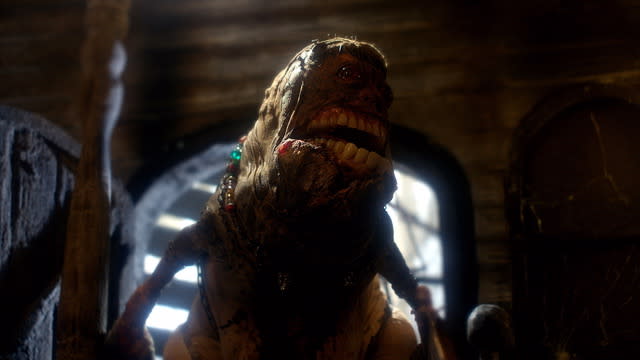‘Star Wars’ VFX Artist Phil Tippett on Premiering His ‘Mad God’ Opus and Leaving ‘Hollywood Filmmaking’ Behind

An extinction event has brought an end to Phil Tippett’s dinosaur days.
The legendary “Star Wars” and “Jurassic Park” VFX artist who helped bring George Lucas’ galactic menagerie to life, who gave teeth to Steven Spielberg’s T. Rex, is preparing to unveil his greatest work, while leaving “Hollywood filmmaking” in the Mesozoic-view mirror.
More from Variety
Reason8 Picks Up Locarno-Bound Russian Drama 'Medea' (EXCLUSIVE)
Asian Shadows Acquires Locarno Selection 'Shankar's Fairies' (EXCLUSIVE)
Oscar Winner Stefan Ruzowitzky's Locarno-Bound 'Hinterland' Unveils Trailer (EXCLUSIVE)
For the last 30 years, Tippett has been toiling away at “Mad God,” an experimental animation set in a “ghost world of mankind.” The film was funded in large part by a Kickstarter campaign, has no describable plot, and almost drove Tippett insane.
A final cut will have its world premiere next week at the Locarno Film Festival, where Tippett will pick up a lifetime achievement award and introduce two standout titles (namely “RoboCop” and “Starship Troopers”) from his iconic collaboration with director Paul Verhoeven.
Variety caught up with Tippett to discuss his relationship with Verhoeven, his “disenfranchisement” with Hollywood, and a potential “Mad God” sequel which is already in the works.
You’ve been working on “Mad God” for an incredibly long time. What are your expectations now that it’s finally premiering?
I don’t know what to expect at all. All of the friends I’ve shown it to have liked it a great deal, but every single one of them has felt the need to tell me, ‘This film is not for everybody.’ It’s unique.
What made them say that, do you think?
It doesn’t adhere to the normal structures of narrative. It’s driven much more by my unconscious than it is by any conventional filmmaking that has a three-act structure to it. Years ago, I shot about six minutes of footage, way back in the late ’80s. I had to archive it because it was just too big for me, the scope was too big, I didn’t have enough people, so I kind of canned it, but never forgot about it. Over the next 20 years, I studied a number of things like art history and literature, there’s a lot of Dante and Milton in the film, and then I really got into Freud and particularly “The Red Book” by Carl Jung. He wrote it over a period of 16 years, and it drove him insane. A similar thing happened to me. I went down this psychological path that took me into this bizarre world that ended up in the psych ward. It was that kind of experience where I guess I became a method filmmaker, I got lost in this unconscious vision.
You’ve worked with so many great directors, were there any you drew particular inspiration from?
My wife was in the editorial department on “Amadeus,” so we got to hang out with Milos Forman a lot, and I asked him if he could give me any advice and what he said was the best advice I’ve ever gotten as a filmmaker which helped chart my course on this film. He said, “If you want to take a good shit, you have to eat a good meal.” The more time you put into something and let it incubate, the better the result, and that’s what that 20-year period did for me. I didn’t work on it directly because the computer revolution happened and I had to do the day job and go out on location and help frame movies, pre-production and post-production, but I would spend the evenings and weekends doing storyboards and getting ready for whatever it was I was going to be doing.
“Mad God” was funded in large part by online donations, is it gratifying that so many of the people who made the film possible will get to see it?
Of course. I was really beholden to the Kickstarter people, they made the first three episodes possible to make. Those were approximately the first half of it, and then I went on to finish it off as a feature. It’s now locked in concrete at around 80 minutes.
That seems remarkably short given the circumstances.
Not for a film that nobody else is paying for! I also got some help from some wealthy friends that gave me some money and allowed me to get over the last few hurdles.
Despite those hurdles, was there always an end in sight?
Nope. It’s like putting one foot after the next with this thing. I had the ending, but there was a lot more in the roll up to it, a lot more experimental stuff in the buildup. I did some stuff which was kind of like Kubrick in “2001” with liquid suspensions and chemicals. A lot of the time I had no idea what I was doing, working with a lot of chemicals and dyes where I was pouring one into the other. I shot them at different speeds too, high speed, time lapse speed.

Would you describe the process of making the film as chaotic?
I would say I was very influenced by the artist Joseph Cornell. He would go to junk stores and antique stores and pick up things. He might go into one store and see a yellow parrot and buy that for 95 cents, then he’d come home and put it in a box with other parrots. It might come to something, it might not. He usually worked on three or four things at the same time, which is what I did. I had three or four setups going at the same time. When you get stuck or you need time to think about it, you just pull out that thing you need, the yellow parrot. I’m an obsessive collector of not anything worthwhile, just stuff. This film is like I invited stuff into this gravitational field that eventually condenses into something. I don’t know how to put it any other way. It’s a very mercurial process, it took its own path.
The world of “Mad God” seems dream-like, is that accurate?
Yes, I always thought of this thing as a memory or a ghost world of mankind. It’s what our consciousness was left with after we left. It’s an idea of a dream within a dream. It definitely has narrative structure to it that you follow all the way through, but I wanted to hit on some feeling of evolution. A lot of my interest in my unconscious was developed by writing my dreams down; I’m a very prolific dreamer. Over the years, what I was looking for was the structure of the dreams. What I learned from that was that all of them have a beginning, middle and an end. The beginning part of the dream will be resolved by the end. It doesn’t mean everything will be answered, but it goes all the way around. That was my guide for thinking forward for the film.
Is there a resolution, in a sense?
In a sense that made sense to me.
Will it make more sense once audiences have seen it?
The best I can do is a conversation like this and have people ask me questions. I couldn’t tell you what the premise is, but what I’m looking forward to at Locarno is seeing how people react to the film. I had a screening of the film as a work in progress at MOMA a number of years ago, and I sat at the back of the theatre. There were about 200 people in the house, and I counted 13 that walked out. I went and caught up with them and asked why they walked out? Pretty much all of them said it gave them an anxiety attack. That’s when I knew I was onto something, that was really good.
Will you do the same at Locarno?
Yep. I’m going to sit at the back of the theatre with my iPhone ready and count how many people walk out, and then turn my phone to record at the end to see if I get boos, a standing ovation, or something in between. That’s very exciting to me.
What if the whole theatre has emptied itself by the end?
I’d call that some form of success.

The festival is also screening “RoboCop” and “Starship Troopers,” two of your greatest collaborations with Paul Verhoeven. How significant has that artistic relationship been in your career?
Paul turned out to be a mentor to me. I had been a huge fan of all his movies, so I was amazed to work on those films with him. We have very similar world views, I think. We’re both misanthropic, all we have is hope. It’s a far cry from Lucas and Spielberg. It comes from a different place. It all adheres to conventional narrative forms, but his work is much more like an artist putting things together than a commercial filmmaker that’s trying to make a billion dollars off a dinosaur.
So your dinosaur days are done?
Oh yes, that’s way in my past. I’m over dinosaurs, I’m over robots, I’m over space aliens. Part of of making “Mad God” was a reactionary thing. It didn’t start off that way, but it grew because I was so disenfranchised with Hollywood filmmaking and what a pit it has driven itself into. Now, the nomenclature of the day is content, content, content, and it’s more like hot air, hot air, hot air. I wanted to make something that grabs people’s attention and takes you some place where you had never been before, and you have no idea where it’s going. That’s very clear to some people. Others who are in it for a more conventional theatrical experience are going to be disappointed. I’ve moved through these different environments before, and I’m thinking what’s next.
What is next?
Over COVID, I got this idea for a kind of sequel, but it’s in no way as labyrinthian and dark as “Mad God.” I wanted something that people would give me money for this time that I could complete in a couple years. It’s designed to be a lot more audience friendly with characters and plot. In vibe, it’s like a 1940s Warner Bros. color cartoon. It has that savage insanity to how the energy flows. I spent a good chunk of COVID time writing a narrative, I’ve designed all the characters, drawn all the storyboards, so it’s just sitting there in case I get any traction.
Maybe, if everyone doesn’t walk out of the screening at Locarno, you’ll get to make it?
We’ll see. I would recommend either taking a gummy, smoking some marijuana, drinking a bottle of wine, or bringing a vomit bag to watch it.
I’m not sure the first two options are legal in Switzerland.
A bottle of wine and a vomit bag it is then.
Best of Variety
Sign up for Variety’s Newsletter. For the latest news, follow us on Facebook, Twitter, and Instagram.

 Yahoo Movies
Yahoo Movies 
